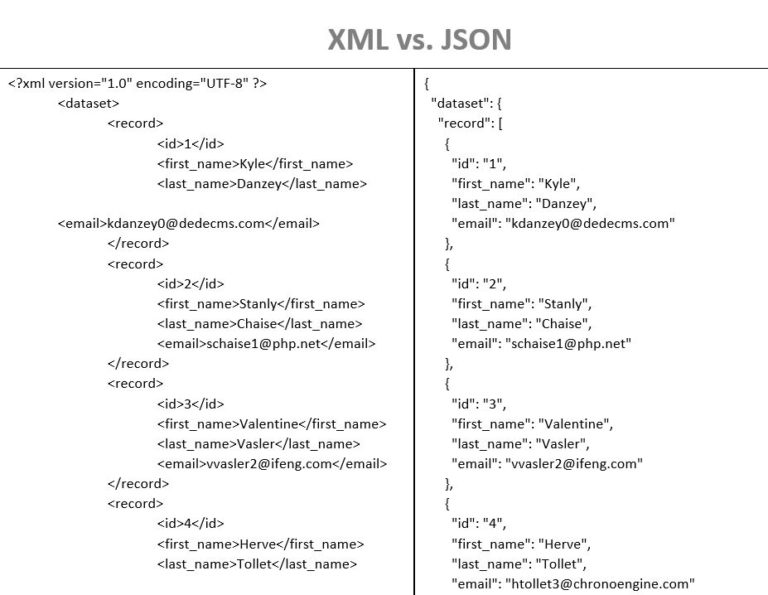
When deciding which data format is best for data analysis, there is no definitive answer as it depends on your data characteristics, analysis objectives, and available tools. Generally speaking, CSV should be chosen if the data is simple, flat, and tabular, and you are working with common software and languages. JSON should be chosen if the data is complex, nested, and object-oriented, and you are working with web applications and APIs. Finally, XML should be chosen if the data is rich, hierarchical, and document-based, and you are working with XML standards and formats. Converting between different data formats may result in some loss or distortion of information so it is better to choose the most suitable format from the start.
more stack exchange communities
The Health Level Sever (HL7) standard, (HL7), is a globally recognized standard for handling electronic health information. With its hierarchical structure, XML helps manage complex data sets, like patient records and medical orders. Researchers, data scientists, and machine learning engineers use CSV as the go-to file format for storing and exchanging datasets, so do I. To turn your CSV files into DataFrames, I mostly use Python’s Pandas library that I also recommend you to explore.
Flexter
Python works well with both small and large XML files because it is easy to use, has a strong community behind it, and works well. Although PHP is capable of converting XML, Python, C#, and Java outperforms it in terms of performance, advanced features, and library ecosystem. It’s not good for batch XML processing because it’s focused on web development and doesn’t work well with large or complicated XML files. To change XML to CSV, you can use a number of programming languages and command-line scripting frameworks, like Bash or Shell.
Data Format Types: CSV, JSON, & XML Demystified
A delimiter is the space that separates each field or value in a row. The easiest way to create a CSV file is to use tools such as our PDF.co PDF to CSV API. You can also use a spreadsheet program to save your document as a CSV file. Unlike a text editor, a spreadsheet will display a CSV in a way that you can read easily.
- Specifically, these attacks can be executed when the CSV data includes entries that are interpreted as formulas by these spreadsheet programs.
- XML (Extensible Markup Language) is a markup language that defines a set of rules for encoding hierarchically organized documents.
- Structured, human readable, easier to edit, validation, parsability, transformability, typing, namespaces, powerful libraries behind it, are all amongst many of the reasons.
- CSV is useful when you just have a series of a values that relate to some piece of information and you know you will always store values for each field.
- To turn your CSV files into DataFrames, I mostly use Python’s Pandas library that I also recommend you to explore.
HTML Table to CSV Converter

If you work with data, you probably encounter different data formats, such as CSV, JSON, or XML. These formats have different advantages and disadvantages for data analysis, depending on your goals, tools, and data sources. In this article, we will compare these three common data formats and give you some tips on how to choose the best one for your data analysis needs. The environment your application lives in may call for the use of two or more of these file formats because of separate systems, each with different requirements.
FAQ on XML to CSV Converters
These systems will still need to communicate efficiently with each other, requiring you to convert data from one file format to another. I’ve found XML is usually better than CSV or JSON when I need a more robust configuration file. XML’s hierarchical structure makes it easier to define detailed complex relationships between different elements. Apache Tomcat uses XML, for example, to configure things like engines, connectors, and virtual hosts with a server.xml file.
R can be very useful if you want your application to use web data for data science applications. In Machine Learning, CSV files are the most common format, easily accepted as input to many functions of well-received Python libraries, (like Pandas of Scikit-Learn). Their compact size boosts processing efficiency, which is great for handling large datasets like those found on Kaggle, a platform for data science competitions and resources. It’s big and not very fast, but you can carry huge amounts of a variety of stuff in it, and the complexity of the vehicle requires more know how to drive than the average car.
The XML sitemap is a more complex file that conforms to the sitemap standard published on sitemaps.org. In addition to being written in an XML format, this sitemap optionally includes the date when the file was last modified, a relative priority value and an approximate change frequency. Asides from what Allain Lalonde already said, one additional advantage of CSV is that it tends to csv vs xml be more compact than XML or even JSON. So, if your data is strictly tabular, with a completely flat hyerarchy, CSV may be a correct choice. Additonal disadvantages of CSV is that it may use different delimiters and decimal separators, depeding on which tool (and even country!) generated it. Don’t know if it is useful for a REST service however as it skips that whole HTTP layer too.

